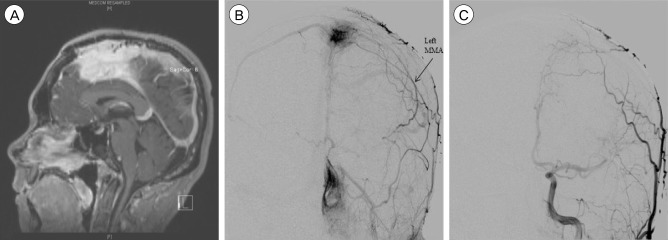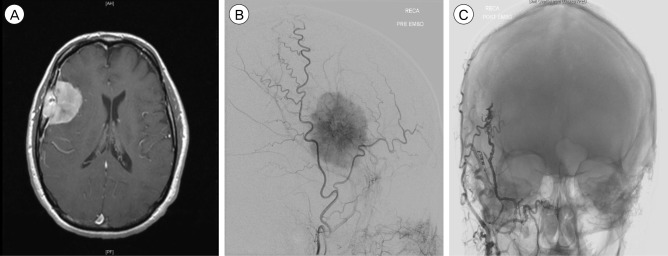J Cerebrovasc Endovasc Neurosurg.
2016 Mar;18(1):12-18. 10.7461/jcen.2016.18.1.12.
Preoperative Embolization of Extra-axial Hypervascular Tumors with Onyx
- Affiliations
-
- 1Department of Neurological Surgery, Vanderbilt University Medical Center, Nashville, TN, USA.
- 2Division of Neurosurgery, Department of Surgery, Beth Israel Deaconess Medical Center and Harvard Medical School, Boston, MA, USA.
- 3Department of Neurosurgery, Barrow Neurological Institute, Phoenix, AZ, USA. Bgross83@gmail.com
- KMID: 2161697
- DOI: http://doi.org/10.7461/jcen.2016.18.1.12
Abstract
OBJECTIVE
Preoperative endovascular embolization of intracranial tumors is performed to mitigate anticipated intraoperative blood loss. Although the usage of a wide array of embolic agents, particularly polyvinyl alcohol (PVA), has been described for a variety of tumors, literature detailing the efficacy, safety and complication rates for the usage of Onyx is relatively sparse.
MATERIALS AND METHODS
We reviewed our single institutional experience with pre-surgical Onyx embolization of extra-axial tumors to evaluate its efficacy and safety and highlight nuances of individualized cases.
RESULTS
Five patients underwent pre-surgical Onyx embolization of large or giant extra-axial tumors within 24 hours of surgical resection. Four patients harbored falcine or convexity meningiomas (grade I in 2 patients, grade II in 1 patient and grade III in one patient), and one patient had a grade II hemangiopericytoma. Embolization proceeded uneventfully in all cases and there were no complications.
CONCLUSION
This series augments the expanding literature confirming the safety and efficacy of Onyx in the preoperative embolization of extra-axial tumors, underscoring its advantage of being able to attain extensive devascularization via only one supplying pedicle.
Keyword
Figure
Reference
-
1. Ding D, Kreitel D, Liu KC. Onyx embolization of an intracranial hemangiopericytoma by direct transcranial puncture. Interv Neuroradiol. 2013; 12. 19(4):466–470. PMID: 24355151.
Article2. Dowd CF, Halbach VV, Higashida RT. Meningiomas: the role of preoperative angiography and embolization. Neurosurg Focus. 2003; 7. 15(1):E10. PMID: 15355012.
Article3. Elhammady MS, Peterson EC, Johnson JN, Aziz-Sultan MA. Preoperative onyx embolization of vascular head and neck tumors by direct puncture. World Neurosurg. 2012; May-Jun. 77(5-6):725–730. PMID: 22079824.
Article4. Gobin YP, Murayama Y, Milanese K, Chow K, Gonzalez NR, Duckwiler GR, et al. Head and neck hypervascular lesions: embolization with ethylene vinyl alcohol copolymer--laboratory evaluation in Swine and clinical evaluation in humans. Radiology. 2001; 11. 221(2):309–317. PMID: 11687669.
Article5. Gore P, Theodore N, Brasiliense L, Kim LJ, Garrett M, Nakaji P, et al. The utility of onyx for preoperative embolization of cranial and spinal tumors. Neurosurgery. 2008; 6. 62(6):1204–1211. PMID: 18824987.
Article6. Kai Y, Hamada J, Morioka M, Yano S, Todaka T, Ushio Y. Appropriate interval between embolization and surgery in patients with meningioma. AJNR Am J Neuroradiol. 2002; 1. 23(1):139–142. PMID: 11827886.7. Pierot L, Cognard C, Herbreteau D, Fransen H, van Rooi WJ, Boccardi E, et al. Endovascualr treatment of brain arteriovenous malformations using a liquid emboilc agent: results of a prospective, multicentre study (BRAVO). Eur Radiol. 2013; 10. 23(10):2838–2845. PMID: 23652849.8. Rangel-Castilla L, Shah AH, Klucznik RP, Diaz OM. Preoperative Onyx embolization of hypervascular head, neck, and spinal tumors: experience with 100 consecutive cases from a single tertiary center. J Neurointerv Surg. 2014; 1. 6(1):51–56. PMID: 23268473.
Article9. Rossitti S. Preoperative embolization of lower-falx meningiomas with ethylene vinyl alcohol copolymer: technical and anatomical aspects. Acta Radiol. 2007; 4. 48(3):321–326. PMID: 17453504.
Article10. Shah AH, Patel N, Raper DM, Bregy A, Ashour R, Elhammady MS, et al. The role of preoperative embolization for intracranial meningiomas. J Neurosurg. 2013; 8. 119(2):364–372. PMID: 23581584.
Article11. Shi ZS, Feng L, Jiang XB, Huang Q, Yang Z, Huang ZS. Therapeutic embolization of meningiomas with Onyx for delayed surgical resection. Surg Neurol. 2008; 11. 70(5):478–481. PMID: 18261767.
Article12. Taki W, Yonekawa Y, Iwata H, Uno A, Yamashita K, Amemiya H. A new liquid material for embolization of arteriovenous malformations. AJNR AM J Neuroradiol. 1990; Jan-Feb. 11(1):163–168. PMID: 2105599.
- Full Text Links
- Actions
-
Cited
- CITED
-
- Close
- Share
- Similar articles
-
- Preoperative Embolization of Hypervascular Brain Tumor Fed by Branches of the Internal Carotid Artery
- Complication Associated with Onyx Embolization of Spinal Cord Arteriovenous Malformation
- Preoperative Embolization of Cerebellar Hemangioblastoma with Onyx: Report of Three Cases
- Hairball-Like Migration of “Onyx Threads” into the Draining Vein during Transarterial Embolization of a Dural Arteriovenous Fistula: A Case Report and Experimental Validation
- Therapeutic Embolization of Renal Tumor






